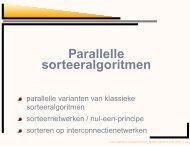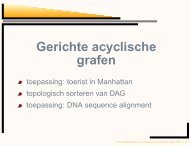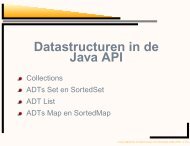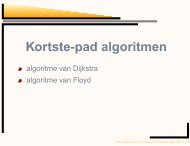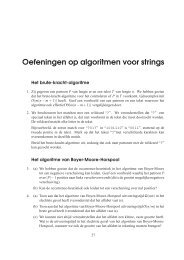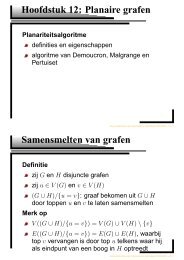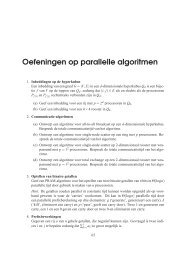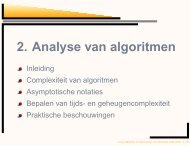- Page 1: Ghent University Faculty of Science
- Page 5 and 6: Dankwoord Deze thesis zou er zeker
- Page 7 and 8: Contents Summary vii 1 Introduction
- Page 9 and 10: Contents v 5.2.1 Introduction . . .
- Page 11 and 12: Summary In this thesis we develop e
- Page 13 and 14: Summary ix represent carbon atoms.
- Page 15 and 16: Chapter 1 Introduction A graph is a
- Page 17 and 18: 1.1. Definitions and preliminaries
- Page 19 and 20: 1.2. Exhaustive generation 5 A k-fa
- Page 21 and 22: 1.3. Isomorphism-free generation 7
- Page 23 and 24: 1.3. Isomorphism-free generation 9
- Page 25 and 26: Chapter 2 Generation of cubic graph
- Page 27 and 28: 2.2. The generation algorithm 13 of
- Page 29 and 30: 2.3. Generation of prime graphs 15
- Page 31 and 32: 2.3. Generation of prime graphs 17
- Page 33 and 34: 2.3. Generation of prime graphs 19
- Page 35 and 36: 2.3. Generation of prime graphs 21
- Page 37 and 38: 2.3. Generation of prime graphs 23
- Page 39 and 40: 2.3. Generation of prime graphs 25
- Page 41: 2.3. Generation of prime graphs 27
- Page 45 and 46: 2.4. Generation of graphs with redu
- Page 47 and 48: 2.4. Generation of graphs with redu
- Page 49 and 50: 2.5. Generation of non-prime graphs
- Page 51 and 52: 2.5. Generation of non-prime graphs
- Page 53 and 54: 2.5. Generation of non-prime graphs
- Page 55 and 56: 2.5. Generation of non-prime graphs
- Page 57 and 58: 2.6. Generation of graphs with girt
- Page 59 and 60: 2.6. Generation of graphs with girt
- Page 61 and 62: 2.7. Generation of graphs with conn
- Page 63 and 64: 2.7. Generation of graphs with conn
- Page 65 and 66: 2.9. Closing remarks 51 strongly on
- Page 67 and 68: 2.9. Closing remarks 53 All connect
- Page 69 and 70: Chapter 3 Generation of snarks In t
- Page 71 and 72: 3.1. Introduction 57 smallest snark
- Page 73 and 74: 3.3. The generation algorithm 59 As
- Page 75 and 76: 3.4. Optimisations 61 At first sigh
- Page 77 and 78: 3.4. Optimisations 63 the non-isomo
- Page 79 and 80: 3.5 Testing and results 3.5. Testin
- Page 81 and 82: 3.5. Testing and results 67 Order 1
- Page 83 and 84: 3.6. Closing remarks 69 Figure 3.2:
- Page 85 and 86: 3.6. Closing remarks 71 snarks of s
- Page 87 and 88: Chapter 4 Generation of fullerenes
- Page 89 and 90: 4.1. Introduction 75 However, Whitn
- Page 91 and 92: 4.1. Introduction 77 incomplete in
- Page 93 and 94:
4.2. Generation of fullerenes 79 or
- Page 95 and 96:
4.2. Generation of fullerenes 81 C
- Page 97 and 98:
4.2. Generation of fullerenes 83 00
- Page 99 and 100:
4.2. Generation of fullerenes 85 wi
- Page 101 and 102:
4.2. Generation of fullerenes 87 We
- Page 103 and 104:
4.2. Generation of fullerenes 89 e
- Page 105 and 106:
4.3. Generation of IPR fullerenes 9
- Page 107 and 108:
4.3. Generation of IPR fullerenes 9
- Page 109 and 110:
4.3. Generation of IPR fullerenes 9
- Page 111 and 112:
4.3. Generation of IPR fullerenes 9
- Page 113 and 114:
4.3. Generation of IPR fullerenes 9
- Page 115 and 116:
4.3. Generation of IPR fullerenes 1
- Page 117 and 118:
4.3. Generation of IPR fullerenes 1
- Page 119 and 120:
4.3. Generation of IPR fullerenes 1
- Page 121 and 122:
4.3. Generation of IPR fullerenes 1
- Page 123 and 124:
4.3. Generation of IPR fullerenes 1
- Page 125 and 126:
4.3. Generation of IPR fullerenes 1
- Page 127 and 128:
4.4. Testing and results 113 adding
- Page 129 and 130:
4.4. Testing and results 115 number
- Page 131 and 132:
4.4. Testing and results 117 nv nf
- Page 133 and 134:
4.4. Testing and results 119 nv nf
- Page 135 and 136:
4.4. Testing and results 121 nv nf
- Page 137 and 138:
4.4. Testing and results 123 Figure
- Page 139 and 140:
4.5. Closing remarks 125 Figure 4.3
- Page 141 and 142:
Chapter 5 Ramsey numbers In the fir
- Page 143 and 144:
5.2. Generalised triangle Ramsey nu
- Page 145 and 146:
5.2. Generalised triangle Ramsey nu
- Page 147 and 148:
5.2. Generalised triangle Ramsey nu
- Page 149 and 150:
5.2. Generalised triangle Ramsey nu
- Page 151 and 152:
5.2. Generalised triangle Ramsey nu
- Page 153 and 154:
5.2. Generalised triangle Ramsey nu
- Page 155 and 156:
5.2. Generalised triangle Ramsey nu
- Page 157 and 158:
5.2. Generalised triangle Ramsey nu
- Page 159 and 160:
5.2. Generalised triangle Ramsey nu
- Page 161 and 162:
5.2. Generalised triangle Ramsey nu
- Page 163 and 164:
5.2. Generalised triangle Ramsey nu
- Page 165 and 166:
5.3. Classical triangle Ramsey numb
- Page 167 and 168:
5.3. Classical triangle Ramsey numb
- Page 169 and 170:
5.3. Classical triangle Ramsey numb
- Page 171 and 172:
5.3. Classical triangle Ramsey numb
- Page 173 and 174:
5.3. Classical triangle Ramsey numb
- Page 175 and 176:
5.3. Classical triangle Ramsey numb
- Page 177 and 178:
5.3. Classical triangle Ramsey numb
- Page 179 and 180:
5.3. Classical triangle Ramsey numb
- Page 181 and 182:
5.3. Classical triangle Ramsey numb
- Page 183 and 184:
5.3. Classical triangle Ramsey numb
- Page 185 and 186:
5.3. Classical triangle Ramsey numb
- Page 187 and 188:
5.3. Classical triangle Ramsey numb
- Page 189 and 190:
5.3. Classical triangle Ramsey numb
- Page 191 and 192:
5.3. Classical triangle Ramsey numb
- Page 193 and 194:
5.3. Classical triangle Ramsey numb
- Page 195 and 196:
5.3. Classical triangle Ramsey numb
- Page 197 and 198:
Appendix A Notation 183
- Page 199 and 200:
Appendix B Ramsey numbers of connec
- Page 201 and 202:
187 and contains one of the graphs:
- Page 203 and 204:
Appendix C Number of Ramsey graphs
- Page 205 and 206:
191 edges number of vertices n e 19
- Page 207 and 208:
193 edges number of vertices n e 29
- Page 209 and 210:
Bibliography [1] E. Albertazzi, C.
- Page 211 and 212:
Bibliography 197 [23] G. Brinkmann
- Page 213 and 214:
Bibliography 199 [48] G. Exoo. On t
- Page 215 and 216:
Bibliography 201 [74] C. Justus. Tr
- Page 217 and 218:
Bibliography 203 [101] S.P. Radzisz
- Page 219 and 220:
Bibliography 205 [126] C.Q. Zhang.
- Page 221 and 222:
Nederlandstalige samenvatting In de
- Page 223 and 224:
Nederlandstalige samenvatting 209 v
- Page 225 and 226:
List of Figures 1.1 The basic edge
- Page 227 and 228:
List of Figures 213 4.13 An L 2 exp
- Page 229 and 230:
List of Tables 2.1 Number of prime
- Page 231 and 232:
List of Tables 217 5.2 Counts and g
- Page 233 and 234:
Index 219 edge-cut, 4 embedding, 74



